History of St John's Cathedral and Faith in Argyll and The Isles
Our story in Oban begins with the Victorians, though the Episcopal Church itself has a long and momentous history in the West Highlands and began with the Celtic Church - have a look for some of these early saints names in our Choir Stalls
ar n-eachdraidh ~ our history
The earliest Christian message probably came with the Roman army when ancient local beliefs were given new meaning as the good news of Jesus was shared. The earliest known Scottish saint was Ninian – born around 350AD in Galloway. When the Romans left, the church declined, but was fanned back to life by Columba and Kentigern, Brendan and Moluag.
Columba, born in 521 in Ireland, arrived in Iona with his 12 companions in 563. From that base they shared the gospel across Dalriata, to the Picts and down to Northumbria. Columba died in 597 but Iona remained the hub of the church here for 2 hundred years. Recent excavations of the site of his reading hut, by the Abbey date it to his time.
Moluag reached Lismore, tradition tells, before Columba reached Iona, indeed it is said that Moluag gained the island which both preferred, with its easy routes to evangelise both north and east. From Lismore, alongside over 100 monasteries, Moluag set up places of spiritual learning in Rosemarkie and Mortlach and with his command of the local dialects was able to readily converse and convert the Picts.
Roman Christianity continued to move northwards and in 664AD a Synod in Whitby demonstrated its dominance over the Celtic ways. This, together with constant Viking raids in the 9th and 10th centuries saw Iona destroyed.
Before the 1689 Revolution, the church in Scotland was Episcopalian, but its support of the Jacobite cause saw it severely penalised. The Presbyterian Church of Scotland was established and an independent non-established Scottish Episcopal Church was formed.
In 1819 Argyll, The Isles and Ross were united under Bishop David Low who resided in Fife but in 1846 Argyll and The Isles were separated from Moray and Ross—being endowed £8000 by Bishop Low. The Rev’d Alexander Ewing of Forres was elected the first Bishop of this United Diocese. Under his episcopate and that of his 2 successors - George Mackarness and Alexander Chinnery-Haldane, congregations and buildings gradually increased.
St John's congregation was first gathered in 1846, when Oban was only a village and the present site was open fields. The original architect, Charles Wilson, died before the plans were finalised, and his partner David Thomson picked up the commission and designed what is now the middle zone of the Cathedral, completed in 1864. Some of the congregation were Anglicans from England and Ireland, but many were local Episcopalians from Appin, Ballachulish, and Glencoe, where the Episcopal Church has existed in continuity from the times before the Disestablishment. Two local lairds, MacDougall of Dunollie and Campbell of Dunstaffnage, were crucial to the project of starting a building, and both the families are still connected with the congregation.
In 1882 a south aisle (which is now the Narthex) was added. Bishop Chinnery-Haldane had plans underway for a new church building in Oban, and on his premature death in 1906 the congregation was encouraged to build a new Church as his memorial. Plans were drawn up by James Chalmers of Glasgow for a large church, of Cathedral proportions, to be built on the existing site. Much of the funding derived from the Bishop's own family, including the cost of the magnificent reredos behind the High Altar.
Work finished when funds were exhausted in August 1910, and by then only the Sanctuary, Chancel, one Transept and one bay of the Nave were completed. This was knitted in to the existing building, albeit that the latter was twelve foot lower than the Sanctuary, and oriented at right angles to the new structure, which had to be supported by remarkable steel buttresses.
In 1920 the Church of St John’s, Oban became the Cathedral of the Diocese of Argyll and The Isles.
In general terms the building has remained unchanged ever since, despite two major campaigns to rebuild or complete it. One, the famous Oban Cathedral Fund Appeal run from Staten Island, New York, and spearheaded by the redoubtable Mary Alice Cisco, foundered in the Crash on Wall Street.
The other, led by two Highland Chiefs from the Diocese, Maclean of Duart and Cameron of Lochiel, raised funds sufficient for Ian G Lindsay in 1968 to improve the existing structure, the improvements including the creation of the Narthex from the 1882 south aisle. In 1988 the high structure was stabilised after 80 years of settlement and pressures, not the least being the noise of Concorde's trial flights, which were in part monitored by movement to the Cathedral structure, which lay below the flight path. These last works were financed largely by the residuary bequest of a couple who came on their honeymoon to Oban in 1910 and had at that time thought it a shame that the builders had had to call a halt for lack of funds.
A walk around The Cathedral Building ~ see more pictures on our photos page
You will enter the Cathedral today through The Narthex, which was built in 1882, as a side aisle to the original church, and is now both a baptistry for the fine onyx and marble font shown and a meeting place for the congregation. It is thus similar to a 'Galilee Porch', such as is found at Durham Cathedral.
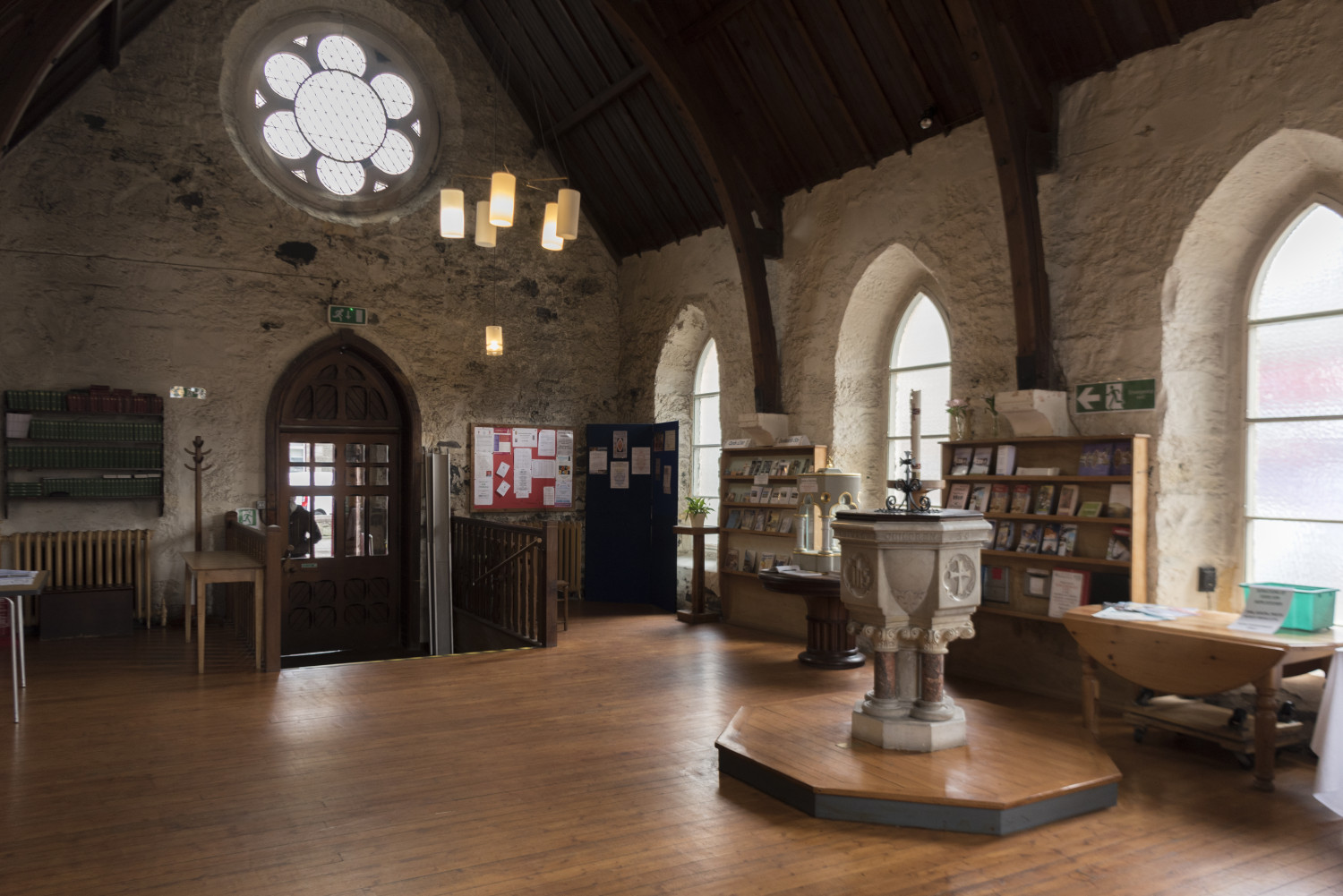
In here you will also see our Donations Box, scupted from the remains of a pulpit found in our crypt by Lucy Gray and dedicatedin 2014. The Narthex also houses our servery, given by a member of our congregation in memory of her husband.
The sliding glass doors were given in memory of a parishioner - Lady Helen Kerr in 1968. There were installed when the floor was raised by several feet and the original stone arcade was demolished.
As you enter, look to your left...
The west wall (formerly the back wall of the original 1864 church) contains two windows with modern paintings by Sarah Campbell of Dunstaffnage. The left-hand window depicts the dream of Jacob at Bethel, linking earth and heaven. His stone pillow is traditionally supposed to be the Coronation Stone formerly in Westminster Abbey, now in Edinburgh Castle, and which was once housed at Dunstaffnage Castle. The right-hand window is the vision of St John the Divine (after whom the building is dedicated), in which the elders cast their crowns on a sea of glass.
If you look to your right....
You will see the three light window, which was the original East Window above the altar of 1864 (now gone). It depicts St John and was given by Sir Donald Campbell of Dunstaffnage in memory of his brother Sir Angus.
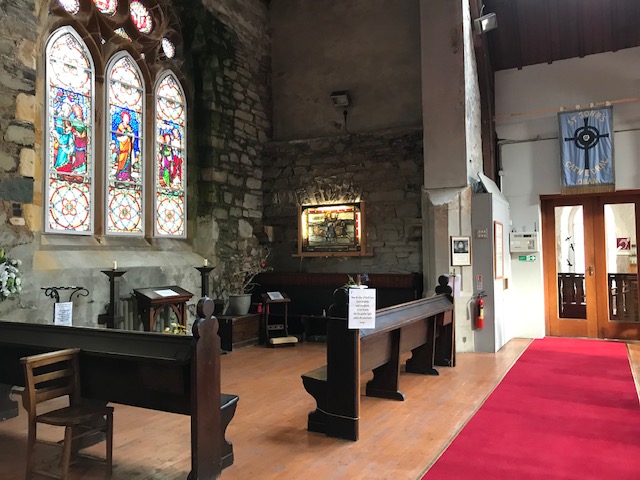
Walking down the aisle - look to your right...
The lifebelt comes from H.M.S. Jason which was hit by an enemy mine near Coll, during the First World War, and 25 people were lost. The crew, before their last fateful tour of duty had worshipped at St John's, which was much used by the Forces during both World Wars. It has been said that many War Memorials are finely designed, but 'this War Memorial was the means of actually saving one or two lives'.
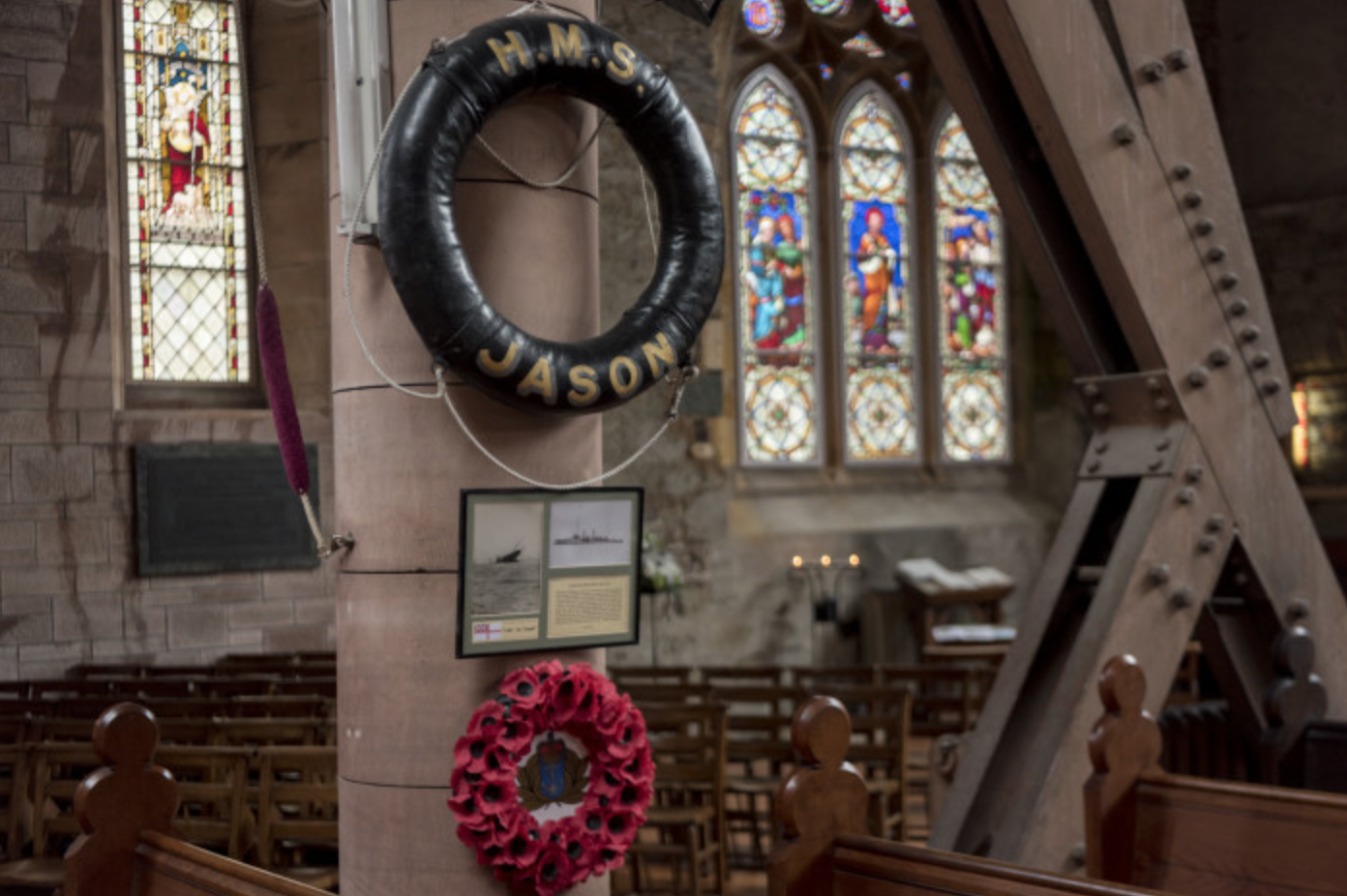
Looking to your left...
You see the pulpit made of St Bees stone with marble and Mexican onyx embellishments. There are carvings depicting Bishops, the emblems of the 4 Evangelists (Matthew, Mark, Luke and John) and St Columba and St Mungo.
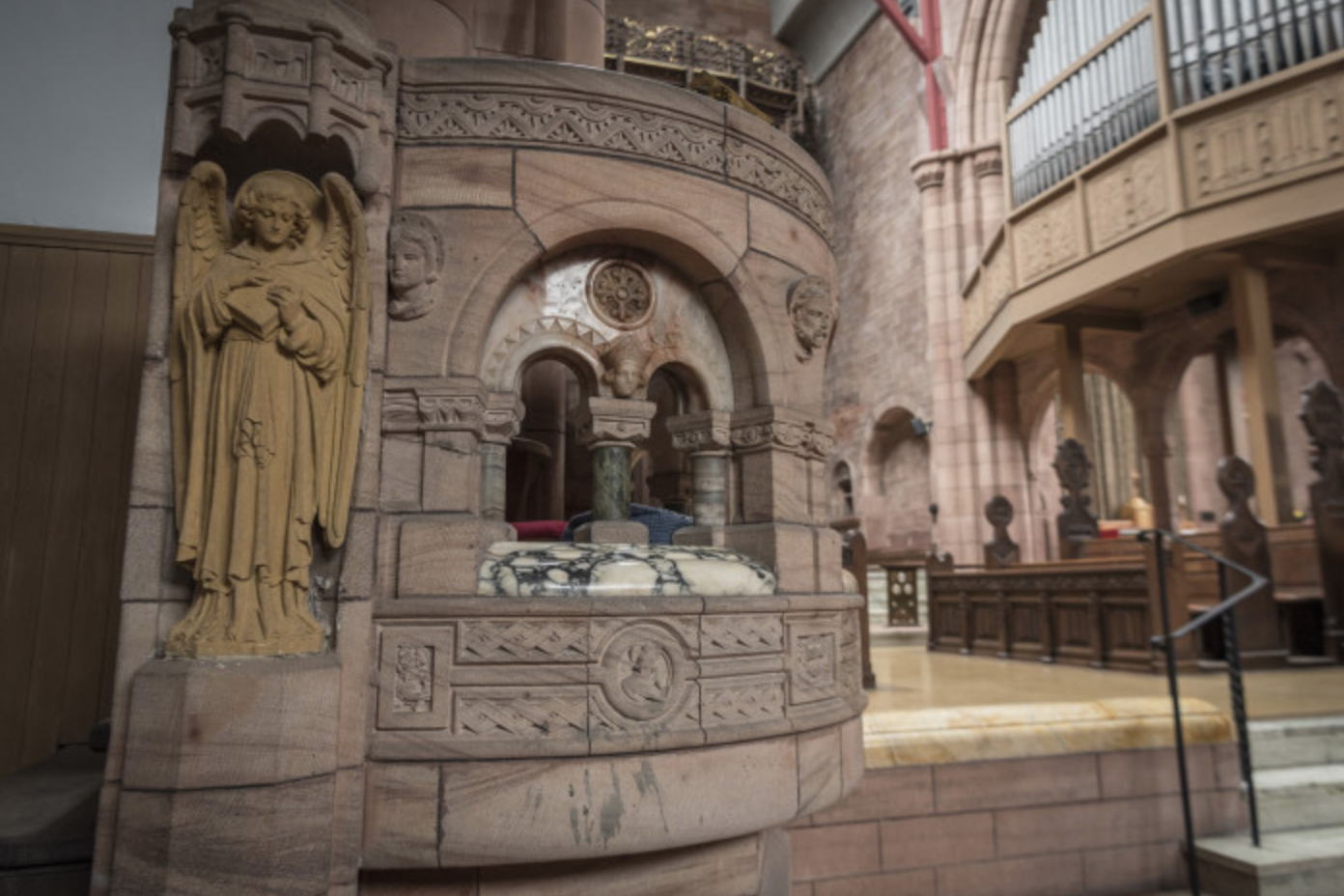
Looking ahead...
The tall Choir Stall ends are intended to represent tall round-headed carved stones in a Celtic graveyard. The carvings on the right hand side include the sign of St Mungo, the Diocesan Arms (with a Blessing issuing from God's hand), and Christ in Majesty; and all the designs have formal 'roots' going down the panel.
The twelve canon stalls in the back row on either side of the choir stalls are dedicated to Celtic Saints. Most of the stalls have tip up seats, such as are found in medieval churches. The Bishop's special stall has a raised canopy, with the Diocesan Arms behind it; while the Provost's stall is surrounded with carved thistle.
The blocked transept arch on the left, contains a massive metal eagle the sign of St John the Evangelist, whose theology is supposed to soar over the rest of the Bible. The bronzed metal sculpture is by George Wyllie, Gourock.
The reredos behind the altar is over 40 feet high, with a canopy including gilded thistles, in a decorative style in contrast to the plain Norman style of the stonework, and was designed by the architect, James Chalmers, himself. It is in memory of Bishop Chinnery-Haldane, who is depicted as St Columba in the right-hand statue. The left-hand statue is St John, who is supposed to have drunk from a poisoned chalice and survived, and the statue has the traditional imagery of a chalice with a little dragon peeping out. The oil paintings, by the Glasgow artist Norman MacDougall, are a synopsis of the life of Jesus Christ; the Annunciation to Mary (the outer two paintings); the Pieta; and above it the Ascension, set looking out over Kerrera (in Oban Bay) with the faces of the apostles being the faces of some of the congregation in 1910.
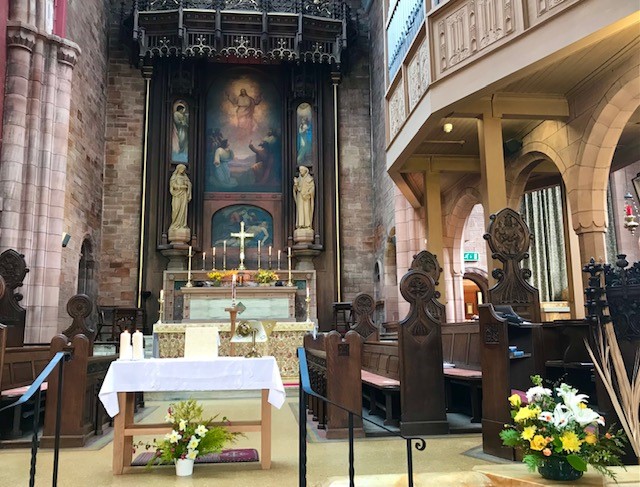
Looking to your right...
The organ, by J Wood and Sons Ltd, was installed in 1994. More details are found under the 'Music at the Cathedral' on our Services page.
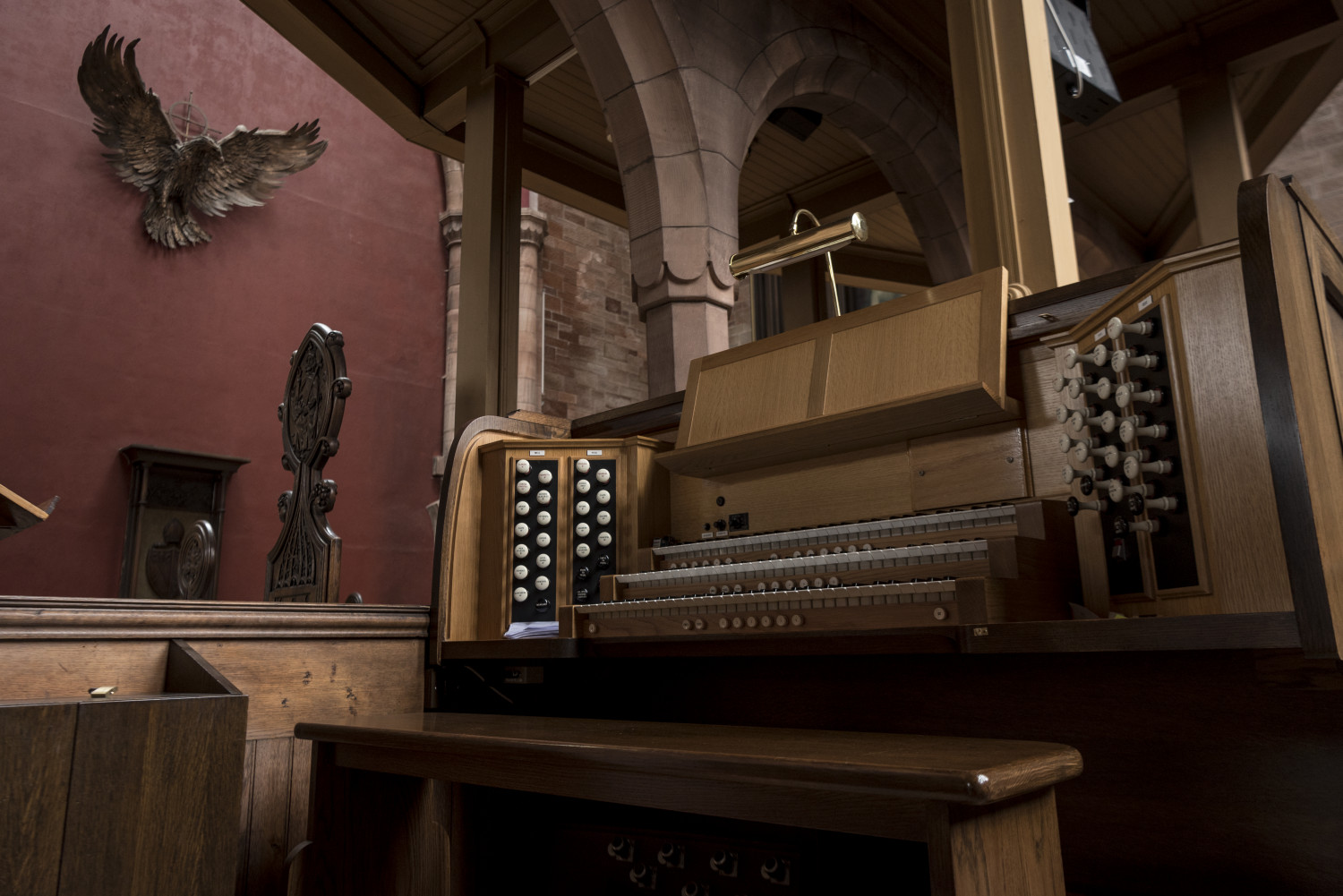
The Lady Chapel altar is made of Sienna Marble and was given in memory of The Dean - Charles Pressley-Smith. He was the first Provost of the Cathedral and resided in what is now the Kings Knoll Hotel....hence the road on which is sits is called Deanery Brae.